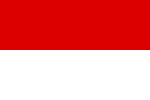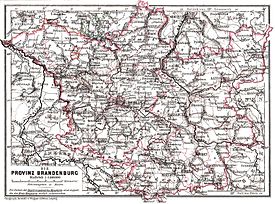Brandenburg Province
| flag | coat of arms |
|---|---|

|

|
| Situation in Prussia | |

|
|
| Consist | 1815-1947 |
| Provincial capital |
Potsdam (until 1827), Berlin (1827–1843), Potsdam (1843–1918), Berlin (1918–1946) |
| surface | 38,274 km² (excluding Berlin, 1939) |
| Residents | 3,007,933 (excluding Berlin, May 1939) |
| Population density | 79 people / km² (excluding Berlin) |
| License Plate |
I E
|
| Arose from | Mark Brandenburg |
| Incorporated into | country Brandenburg |
| Today part of | Brandenburg , Berlin , Poland |
| map | |

|
|
The province of Brandenburg was a province of the Monarchy of Prussia (1815-1918) and the Free State of Prussia (1918-1934). It was essentially formed from the Mark Brandenburg in 1815 and was the heartland of the Prussian state . In the course of the dissolution of Prussia in 1947, it went up in the state of Brandenburg . Other parts of the former territory now belong to the State of Berlin and Poland.
Administrative history
The province of Brandenburg was formed in 1815 and comprised the Mark Brandenburg including the Neumark east of the Oder , but excluding the Altmark west of the Elbe, which had been connected to the province of Saxony . Lower Lusatia also belonged to the province of Brandenburg . The seat of the Upper Presidium (= state provincial government, headed by the Upper President , for which there is no comparable institution today) was initially Potsdam , from 1827 to 1843 Berlin, from 1843 to 1918 Potsdam and from then until 1945 Berlin-Charlottenburg.
On April 1, 1881, Berlin left the Brandenburg Provincial Association and received provincial rights, but without leaving the province entirely. In 1920 further areas of the province of Brandenburg with almost two million inhabitants were incorporated into Greater Berlin . The province of Brandenburg was divided into the two administrative districts of Frankfurt and Potsdam . The administrative districts were divided into urban and rural districts. After the dissolution of the Grenzmark Posen-West Prussia province in 1938, the districts of Schwerin (Warthe), Meseritz and Bomst (partially) came to the province of Brandenburg, which at the same time became the Friedeberg Nm districts. and gave Arnswalde to the province of Pomerania . Since March 21, 1939, the province had the official name "Mark Brandenburg".
As decided at the Potsdam Conference , in 1945 the area of the province east of the Oder-Neisse line was placed under Polish administration and is now part of Poland . The rest of the province was confirmed in June 1945 as the province of Mark Brandenburg in the Soviet zone of occupation . On February 6, 1947, the province went on in the new state of Brandenburg , which had been established as a member state of the future German Democratic Republic (GDR). The Free State of Prussia was dissolved shortly afterwards on February 25, 1947 by the Control Council Act No. 46 .
Population development
| year | Residents |
|---|---|
| 1816 | 1,254,177 |
| 1846 | 2,066,993 |
| 1871 | 2,863,229 |
| 1880 | 3,389,155 |
| 1890 | 2,541,783 |
| 1900 | 3,108,554 |
| 1910 | 4,092,616 |
| 1925 | 2,592,292 |
| 1933 | 2,725,697 |
| 1939 | 3,007,933 |
The population of the province was significantly reduced both in 1881 through the spin-off of the city of Berlin and in 1920 through the expansion of Berlin .
coat of arms
Blazon (without shield holder ): In the silver field a red, gold-armored, red-tongued eagle adorned with the electoral hat . In the right claw he holds a golden scepter, in the left a gold-tipped sword. The wings are decorated with golden clover stems. On the chest is a blue heart shield , in which an upright golden scepter (arch chamberlain) appears.
In the crowned helmet an open black eagle flight covered with golden clover stalks and on the Saxons with golden hearts. The ceilings are black and gold.
Administrative division
Until 1939 the districts were called Kreise
Frankfurt administrative district
City districts :
- City of Cottbus ( since 1886 )
- Forest district (Lausitz) ( since 1897 )
- City of Frankfurt (Oder) ( since 1826 )
- City district of Guben ( since 1884 )
- City district Landsberg (Warthe) ( since 1892 )
Counties :
- District of Calau
- Cottbus district
- District of Crossen (Oder)
- District of Guben
- District of Königsberg Nm.
- Landsberg (Warthe) district
- District of Lebus (District Office until 1863 in Frankfurt / Oder, then in Seelow )
- Luckau district (Nd. Laus.)
- District of Lübben (Spreewald)
- District of Meseritz
- Oststernberg district (district office in Zielenzig )
- District of Schwerin (Warthe)
- Soldin district
- District of Sorau (Lausitz)
- Spremberg district (Lausitz)
- Weststernberg district (district office in Reppen )
- District of Züllichau-Schwiebus (District Office in Züllichau )
Potsdam administrative district
City districts :
- Stadtkreis Lichtenberg ( 1908–1920; then a district of Greater Berlin ) 1
- Stadtkreis Schöneberg ( 1899–1920; then district of Greater Berlin ) 1
- Stadtkreis Wilmersdorf ( 1907–1920; then district of Greater Berlin ) 1
- Stadtkreis Brandenburg (Havel) ( since 1881 )
- City district of Charlottenburg ( 1877–1920; then part of Greater Berlin )
- City of Eberswalde ( since 1911 )
- Stadtkreis Neukölln ( 1899–1920; then district of Greater Berlin )
- Potsdam city district ( since 1809 )
- Rathenow district ( since 1925 )
- Stadtkreis Spandau ( 1886–1920; then part of Greater Berlin )
- Wittenberge district ( since 1922 )
1 from 1912 already listed with the addition of Berlin .
Counties :
- Angermünde district
- Beeskow-Storkow district (district office in Beeskow )
- District of Jüterbog-Luckenwalde (District Office in Jüterbog )
- Niederbarnim district (district office in Berlin )
- District Oberbarnim (District Office in Bad Freienwalde (Oder) )
- Osthavelland district (district office in Nauen )
- District of Ostprignitz (District Office in Kyritz )
- Prenzlau district
- Ruppin District (District Office in Neuruppin )
- Teltow district (district office in Berlin )
- Templin district
- Westhavelland district (district office in Rathenow )
- Westprignitz district (district office in Perleberg )
- District of Zauch-Belzig (District Office in Belzig )
politics
Provincial estates existed for the - considerably restricted - self-government of the provinces until 1875 , to which mainly landowners and cities sent their representatives. As the executive body of the Prussian royal and later state government, it appointed an upper president. He followed the instructions of the government and monitored the implementation of the central requirements at all administrative levels in the province. It was not until 1875, with the strengthening of provincial self-government, that the provincial estates were replaced by the provincial parliament.
Since then, provinces have had a dual nature and dual governing bodies, on the one hand as a subdivision of the central state, and on the other hand as a regional body ( provincial association ) of higher-order local self-government. District assemblies and city councils elected the members of this state assembly. The provincial parliament elected a provincial government, the provincial committee , and a provincial head, the provincial director .
Chief President
- 1815–1824: Georg Christian von Heydebreck
- 1825–1840: Friedrich Magnus von Bassewitz
- 1840–1848: August Werner von Meding
- 1848–1849: Robert von Patow ( acting )
- 1849–1850: Klemens von Wolff-Metternich ( acting )
- 1850–1862: Eduard von Flottwell
- 1862 : Werner von Selchow
- 1862–1879: Gustav von Jagow
- 1879–1899: Heinrich von Achenbach
- 1899–1905: Theobald von Bethmann Hollweg
- 1905–1909: August von Trott zu Solz
- 1909–1910: Friedrich Wilhelm von Loebell
- 1910–1914: Alfred von Conrad
- 1914–1917: Rudolf von der Schulenburg
- 1917–1919: Friedrich Wilhelm von Loebell
- 1919–1933: Adolf Maier
- 1933–1936: Wilhelm Kube
- 1936–1945: Emil Stürtz
Source: Walther Hubatsch (Ed.): Outline of German administrative history 1815–1945 . Series A Preußen, Volume 5 Brandenburg, Marburg 1975, pp. 35-37.
Country Directors
- 1876–1896: Albert von Levetzow
- 1896–1912: Otto von Manteuffel
- 1912–1930: Joachim von Winterfeldt-Menkin
- 1930–1933: Hugo Swart
- 1933–1944: Dietloff von Arnim , from 1937 titled Governor
- 1944–1946: vacancy?
Elections to the provincial assembly
(To 100% missing votes: nominations not represented in the provincial assembly)
- 1921 : SPD 34.1% - 31 seats | Civil association 17.7% - 16 seats | DNVP 17.5% - 16 seats | DVP 11.0% - 10 seats | USPD 8.8% - 8 seats | DDP 6.6% - 6 seats | KPD 3.3% - 3 seats | Center 1.2% - 1 seat | WP 1.0% - 1 seat
- 1925 : SPD 32, 4% - 32 seats | DNVP 28.6% - 28 seats | KPD 8.3% - 9 seats | DVP 6.3% - 6 seats | Urban and rural 5.3% - 5 seats | WP 5.2% - 5 seats | DDP 3.6% - 4 seats | DVFP 2.4% - 2 seats | Center 1.1% - 2 seats | WB Osthavelland 1.0% - 1 seat | DLRP 0.9% - 1 seat | Citizens' block 0.5% - 1 seat
- 1929 : SPD 34.8% - 34 seats | City and Country / DNVP 29.4% - 29 seats | KPD 8.8% - 9 seats | WP 7.6% - 8 seats | NSDAP 5.6% - 6 seats | DDP / Center 4.4% - 4 seats
- 1933 : NSDAP 53.2% - 52 seats | SPD 20.6% - 21 seats | DNVP 15.2% - 15 seats | KPD 7.7% - 8 seats
See also
literature
- Pestalozziverein der Provinz Brandenburg (Hrsg.): The Province of Brandenburg in words and pictures . Berlin W 9, published by Julius Klinkhardt, 1900 (Reprint: Weltbild Verlag, Augsburg 1999, ISBN 3-86047-209-7 )
- Fabian Scheffczyk: The Provincial Association of the Prussian Province of Brandenburg 1933-1945. Regional performance and steering administration under National Socialism . Mohr Siebeck, Tübingen 2008, ISBN 3-16-149761-9
Web links
- Brandenburg province deutsche-schutzgebiete.de
- Province of Brandenburg (counties, municipalities and manor districts) 1910
Individual evidence
- ↑ a b c Statistical Yearbook for the German Reich 1939/40
- ^ Amendment of the Provincial Order, Paragraph 2, in 1881
- ↑ Compare the history of Brandenburg #SBZ and the state of Brandenburg (1945 to 1952) as well as an example of the designation: "School regulations for the province of Mark Brandenburg" from February 15, 1947.
- ^ Constitution for the Mark Brandenburg of February 6, 1947.
- ^ Christian Gottfried Daniel Stein: Handbook of Geography and Statistics of the Prussian State . Vossische Buchhandlung, Berlin 1819, Die Provinz Brandenburg, p. 186 ( books.google.de ).
- ↑ Königliches Statistisches Bureau (Ed.): Mittheilungen des Statistisches Bureau's in Berlin . Population numbers. tape 2 , p. 313 ff . ( books.google.de ).
- ^ Michael Rademacher: German administrative history from the unification of the empire in 1871 to the reunification in 1990. p_brandenburg.html. (Online material for the dissertation, Osnabrück 2006).
- ↑ Maximilian Gritzner : countrymen and heraldry of the Brandenburg-Prussian monarchy , Berlin 1894
- ↑ See article: Provinzialverband . In: Der Große Brockhaus: Handbook of Knowledge in twenty volumes : 21 volumes. 15th edition. Brockhaus, Leipzig 1928–1935; Volume 15 (1933), p. 187 f.
- ↑ In other provinces the term governor was common after 1918, but Brandenburg kept the old title. See article: Country Director . In: Der Große Brockhaus: Handbook of Knowledge in twenty volumes : 21 volumes. 15th edition. Brockhaus, Leipzig 1928–1935; Volume 11 (1932), p. 71.


